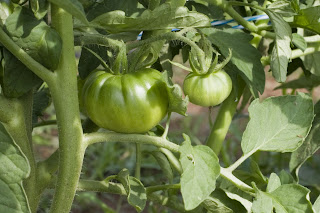This posting comes straight from the
Seasonal Chef:
Kale has earned a spot on many nutritionists’ lists of Top 10 Healthiest Vegetables. As a member of the Brassica family of plants, along with the likes of broccoli and cabbage, it is chock full of phytochemicals that are believed to help prevent cancer. It’s also extraordinarily high in carotenes, which are a good source of Vitamin A, which is good for everything from vision to bone growth, and Vitamin K, which is good for the blood. It’s nutritional attributes don’t stop there. Kale is also an excellent source of raft of other nutrients, including Vitamin C, manganese and calcium. Best of all, kale is good to eat – and is easily incorporated into a wide array of dishes.
Spicy African Kale and Yams
1 large bunch Kale, 4 cups chopped, pressed firm
4 cup Garnet yam, rinsed well, chopped
1 ½ tablespoon olive oil
2 cup Purple cabbage, sliced
1 ½ cup Onion, chopped
3 tablespoon soy sauce
2 tablespoon salt, or to taste
1 tablespoon minced garlic
1 tablespoon ginger, peeled and minced
1 teaspoon serrano chile, seeded and diced
Hot Sauce, to taste
1. Rinse and drain kale well. Steam kale and yams. Kale should still be colorful and yams should still have some firmness.
2. While kale and yams are steaming, place oil in a large sauté pan and heat on medium high. Add onion, garlic, ginger and chili pepper, cook for 5 minutes, stirring frequently.
3. Add cabbage and cook for 5 minutes, stirring frequently. Add small amounts of water if necessary to prevent sticking. Place in a large mixing bowl with remaining ingredients, add kale and mix well.
4. Add yams and gently mix well.
Chinese Sesame Kale
2 cloves garlic, minced
1 pound kale (about bunch)
2 teaspoons sesame seed oil
2 tablespoons water
1 teaspoon soy sauce
2 teaspoons toasted sesame seeds
Salt and pepper, if desired
1. Mince the garlic cloves. Wash the kale and shake it over the sink. It should remain a little wet. Remove and discard the stems from the kale and tear it into bite-size pieces. Save the stems for another use, such as vegetable stock.
2. Heat the sesame seed oil in the skillet over medium-low heat. Add the minced garlic to the hot oil and sauté for about 20 seconds. Add the kale and water to the garlic and oil, and cover the skillet.
3. After 1 minute, stir the kale, then re-cover. After 1-2 more minutes, when the kale is wilted, stir in the soy sauce and sesame seeds. If desired, add salt and/or pepper to taste.
Austrian Kale
2 bunches kale, washed
1 clove garlic, minced
½ medium onion, coarsely chopped
2 tablespoon oil
1 ½ cup chicken stock or bouillon
4 medium potatoes, quartered
1 stalk celery, chopped
Sour cream, for garnish
1. Cut the kale leaves into 1/2-inch-wide strips. Blanch them in lightly salted boiling water for one minute. Set aside.
2. Saute the garlic and onion in the oil until lightly browned. Add the chicken stock, potatoes, celery, and blanched kale. Simmer together until potatoes fall apart and lose their shape. Stir; season with salt and pepper, garnish with sour cream and serve.
Braised Tuscan Kale
4 bunches kale, stems removed
Salt as needed
¼ cup extra-virgin olive oil
½ white onion thinly sliced
½ rosemary sprig
1 dried small red chile
2 garlic cloves thinly sliced
¼ cup chicken stock or water
1. Coarsely chop the kale leaves and blanch them in boiling salted water, about 3 minutes, then drain.
2. Heat the oil in a heavy skillet over medium heat and add the onion, rosemary and chile. Cook for 2 minutes, then add the garlic and 1/4 teaspoon of salt. When the onion is translucent and starting to color, 3 to 5 minutes, add the kale.
3. Cook the kale over medium-low heat for 30 to 40 minutes, stirring often. The kale will turn a deep, almost black color, become soft and then almost a little crisp. Add 1/2 teaspoon of salt. If the greens get too dry during the cooking, stir in a little stock or water.
4. Spoon into a serving bowl and serve.
Italian Pork Chops with Kale
2 lbs kale
1/4 cup olive oil
2 large cloves of garlic, minced
4 thick pork chops
2 teaspoons fennel seeds
1 cup hot water
1 small can tomato paste
1. Soak kale and rinse it thoroughly then simmer for 20 minutes in pot of salted water.
2. While kale is cooking, heat oil in large, deep skillet. Add garlic and cook for 2 minutes over low heat. Add pork chops and saute for 5 minutes on each side, then season with salt, pepper, and fennel seeds.
3. Dissolve tomato paste in hot water and add to pork chops. Cover and cook on low for 30 minutes, adding water if sauce gets too thick.
4. Drain kale and stir into tomato sauce. Cover and cook for another 10 minutes.
Bean and Kale Soup
1/2 lb. dried Great Northern beans
Water as needed
Olive oil as needed
1 onion, chopped
2 small carrots, diced
1 celery stalk, diced
4 cup shredded kale (1 small bunch)
1 boiling potato, diced
2 cup chopped Swiss chard bunch (1 small bunch
1 large tomato, diced
2 garlic cloves, minced
2 teaspoon minced fresh rosemary leaves
1 tablespoon minced parsley
1 teaspoon fresh thyme leaves
Salt to taste
Freshly-ground black pepper to taste
1 cup freshly-grated Parmesan cheese
1. Place beans in large saucepan with enough cold water to cover. Let stand at room temperature overnight.
2. Drain beans and return to saucepan. Add enough water to cover and bring to a boil over high heat. Reduce heat and simmer until tender, 1 hour 30 minutes, reserving liquid. Transfer half of beans to food processor or blender and puree. Reserve remaining whole beans.
3. Heat 1/4 cup oil in large pot over medium-high heat. Add onion, carrots and celery and saute 5 minutes. Stir in kale, potato, pureed beans and enough reserved bean cooking liquid and water to make 6 cups. Heat over medium heat and simmer for about 30 minutes until vegetables are tender.
4. Add chard, tomato, garlic, rosemary, parsley, thyme and salt and pepper to taste. Simmer until chard is tender and flavors are well blended, at least 1 hour, adding additional bean liquid if soup is too thick. (Soup should be quite thick.)
5. Stir in reserved whole beans and simmer until heated through, 5 to 10 minutes. (Can be cooled and refrigerated overnight.) Ladle into heated soup bowls and sprinkle with Parmesan cheese. Top each bowl of soup with spoonful of olive oil, if desired.
Caldo Verde
(Portuguese Kale-Potato-Sausage Soup)
1 large yellow onion, peeled and minced fine
1 large garlic clove, peeled and minced
4 tablespoons olive oil
6 large potatoes
2 quarts cold water
1 pound chorizo or similar sausage
2 1/2 teaspoons salt
1/4 teaspoon pepper
1 lb. kale, chopped
1. Saute the onion and garlic in three tablespoons of oil. Add potatoes and sauté for five minutes. Add water, cover, and boil gently for 20 minutes until potatoes are falling apart.
2. Meanwhile, chop and fry the sausage in a skillet and drain, then add the kale, remaining tablespoon of olive oil, salt and pepper, and simmer for five minutes. Stir sausage and kale into pot of boiled potatoes. Cook for about 20 more minutes and serve with dark bread.















